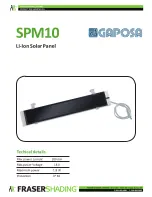
The maximum voltage of the system should not be
exceeded under any circumstances. If the voltage
of the
SOLAR FLAT-5XL ceramic roof tile
were
expected to surpass the values detailed in the data
sheet under operating temperatures lower than 25°C,
this must be taken into account when designing the
photovoltaic system.
Only personnel qualified to work with photovoltaic
capture systems should access or work with
SOLAR
FLAT-5XL ceramic roof tiles
or on the solar system.
Before connecting the
SOLAR FLAT-5XL ceramic
roof tiles
to the inverter, open the circuit breakers and
turn off the inverter.
To prevent electrical discharges, do not carry out
the installation when the
SOLAR FLAT-
5XL ceramic roof tiles
, installation tools or
installation area are exposed to water.
Before switching on the system, make sure all
the
SOLAR FLAT-5XL ceramic roof tiles
are
connected and use a multimeter to check the total
voltage of the entire solar tile installation.
Make sure that all connections have been made safely,
without any space between the contacts. Any space
between contacts may cause an electric arc which is
capable of causing a fire and/or electric discharges.
To prevent the appearance of electric arcs and
discharges, NEVER disconnect a solar tile when it
is charging. If this were ever necessary, cover
the surface of the tile with an opaque covering before
disconnecting it.
Make sure that the polarity of each
SOLAR FLAT-5XL
ceramic roof tile
or string is not inverted in relation to
the rest of the tiles or the strings.
For all connections with inverters, regulators,
batteries or to the general control panel, take into
account the manufacturer’s specifications in each case.
The rated electrical characteristics are within a
range of +5% to -3% of the values measured under
standard test conditions (STC): 1,000 W/sq. m., with
a cell temperature of 25°C and a solar spectrum
corresponding to an air mass of 1.5.
5.6 Installation safety
Solar photovoltaic tiles convert light energy from
sunlight into direct current electricity. They are designed
to be installed outdoors on sloping roofs or facades.
The proper design of the structures which support
the tiles is the responsibility of the system designers
and the installers.
Always use tools and PPE which comply with standards
for electrical installations and working at height.
All electronic components used in the photovoltaic
system (including cables, connectors, charge
regulators, inverters, batteries, etc.) must comply with
safety regulations.
Never unplug connectors or open the electrical circuit
at any point while the circuit is charging or receiving
electric current.
To prevent electrical discharges while handling
the SOLAR FLAT-5XL ceramic roof tiles, we
recommend you cover the surface of the solar tiles with
an opaque material both while installing and removing
them to stop them from generating electricity.
Contact with the electrically charged parts of a SOLAR
FLAT-5XL ceramic roof tile, such as the terminals, may
cause burns, sparks and even lethal shocks, either if
the tile is connected or if it is not.
During the installation, do not touch the photovoltaic
modules unless necessary. The glass surface and
the frame may heat up excessively and there is a
risk of burns or electric shock.
Never install or handle SOLAR FLAT-5XL ceramic roof
tiles if they are wet. Do not carry out the installation
in adverse or severe weather conditions such as high
winds, heavy rain, snow or hail.
To prevent damage to the cables, keep them out of
direct sunlight as much as possible and do not let
them be stained by any product used in assembling
the roof (foam, adhesives, mortar, asphalt, etc.) before
installation.
Only use insulated tools which are authorized for use
in electrical installations.
During the installation, repair or removal of photovoltaic
systems, metallic accessories (bracelets, watches,
rings, earrings or metal piercings anywhere on
the body) must not be worn.
Respect safety regulations (e.g. regulations
concerning working in power plant stations) for all
the other components of the system such as wires
and cables, connectors, load regulators, inverters,
storage batteries, rechargeable batteries, etc.
13














































